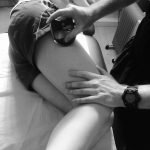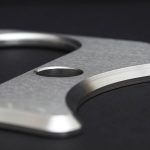Instrument Assisted Soft Tissue Mobilisation or IASTM, is a relatively new method of soft tissue mobilisation that originated in the US in the mid 90’s. It has however got links to more ancient forms of treatment such as Gua Sha which has been around for centuries.
The techniques has become popular because it delivers quick results, with improving range of motion, improving movement quality and decreasing pain. And it does this within a few minutes.
Originally, IASTM was developed as a hand saver for doing treatments such as deep transverse friction massage, breaking down scar tissue and promoting healing in the treated region. Whether this actually occurs with IASTM is still up for debate, there are some preliminary studies that shows some encouraging signs that it may augment the healing process however the jury is still out.
When I do my treatments I am gradually using less and less pressure and still having the same awesome results from it. With the light pressure that I use it is unlikely that I am actually penetrating deep enough into the tissues to cause a a mechanical effect and setting up an inflammatory reaction.
A more likely source of the improvement is through affecting the peripheral and central nervous system. By stimulating the mechanoreceptors and nerve endings in the skin and possibly in the superficial fascia, it is possible to cause a reduction in muscle tone and ‘release’ restrictions we can feel with our IASTM tools.
Let me clarify this a little as I am not certain that we actually feel ‘restrictions’ , however, when we assess the soft tissues with the Edge tool (our preferred IASTM tool) we can usually feel one of three things. Either the tissues are normal and the tool glides on top of the skin smoothly without any obstacles or we can get an increase in tone where the tool slows down in the tissues but still continues to glide across the tissues. The third thing we may feel is small bumps and unevenness in the tissues that feels a little like ‘grit’ under the skin. We cannot be sure what this is, however, they closely relate to areas of decreased movement and areas of pain. What we tend to find is that the areas of increased tone and ‘grit’ quickly dissipates when we apply our treatment technique with the tool. We normally see significant changes in tone and restrictions within 2-3 minutes of treatment, however larger areas may take slightly longer.
So let me try to explain to you how I might use the techniques in the session. Initially I would do my normal physiotherapy assessment consisting a thorough subjective followed by observation and movement based tests. I would then progress to palpate the soft tissues in the movement pattern that is affected and any areas of pain. Say someone is struggling in the saggital plane with forward flexion of the neck. I would then palpate the soft tissues above the muscle groups that both shorten and lengthen during this movement as well as the adjoining muscles that may affect the movement. Normally as this stage, I will highlight areas of increased tone and/or sites of pain. I will then use the tool to assess the area further to determine what the best and most effective form of treatment will be for that issue. If there is in fact a soft tissue restriction I will commence treatment using the IASTM tool.
Once treatment has started I will continually re assess using both the tool and my hand for changes in tissue tone, once the ‘restriction’ has dissipated I will reassess the affected movement pattern again.
The key a this stage is to practice purposeful movement with my patient to use the increased range of motion and this will then form the basis of my home exercise programme.
See the video below for how we might use the technique to release the thoracolumbar fascia to increase thoracic rotation.
If you would like to learn more about this excellent technique and how it can improve your practice, we are running courses with the help of Rocktape UK. Get booked on!



